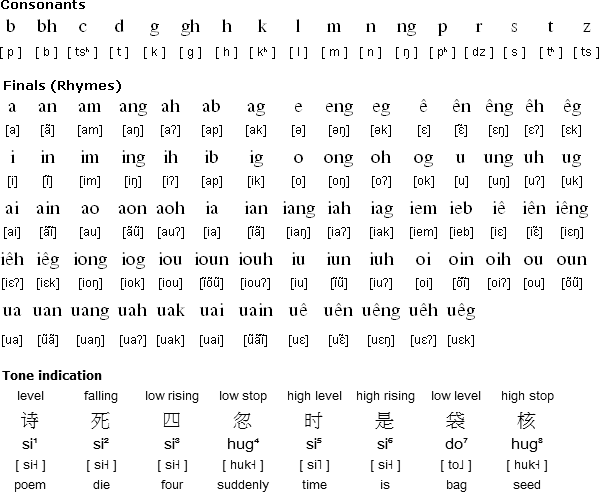Teochew originated in the Chaoshan region of Guangdong province, China. Teochew is also spoken in Hong Kong, Singapore, Malaysia, Indonesia, Vietnam, Cambodia and Thailand.
Teochew is a dialect of Southern Min, a Sinitic language. It preserves a three-way distinction between unvoiced unaspirated, unvoiced aspirated and voiced unaspirated plosives that is absent in Mandarin Chinese. Oral and nasalised vowels form contrasting minimal pairs in Teochew.
Teochew pronunciation

Note on consonants
Syllables can only end in the following sounds: [p], [k], [m], [ŋ] and [ʔ].
The glottal stop never appears in the word-initial position. It can be viewed as a weakened form of the velar stop [k] in the final position. Some speakers pronounce the glottal stop where others pronounce the velar stop.
Unlike Hokkien, another closely related Southern Min dialect, Teochiu words do not end in [t] or [n].
Teochew has two syllabic nasals: [m] and [ŋ].
Note on vowels
Vowel sounds can either be oral or nasal.
There is a great variation in vowel sounds among Teochew speakers. Some speakers pronounce [ɛ] as [e], [ɨ] as [ɜ] or [i], [iɔ] as [iɛ], and [iəu] as [iou] or [iɑu].
Some of the information on this page was provided by Wenkai Tay.
Links
GagiNang - information about Teochiu language and culture
http://gaginang.org
Diojiu Bhung Gak: A Site Teochiu Language
http://teochiu.tripod.com
Chaozhou Mogher - includes information about Chaozhou idioms and phonology and a dictionary
http://www.mogher.com
Chinese Ink in SE Asia: Dialects
http://www.post1.com/home/zhuangfu/dialects.htm
Singapore Teochew Association (in Chinese)
http://www.teochew.org.sg
Sino-Tibetan languages
Sinitic (Chinese) languages
Dungan, Cantonese, Gan Hakka, Mandarin, Shanghainese, Taiwanese, Teochew, Xiang
Tibeto-Burman languages
Burmese, Dzongkha, Garo, Kayah Li, Lepcha, Limbu, Lisu, Manipuri, Naxi, Nepal Bhasa / Newari, Tangut, Tibetan, Tujia, Yi
Teochew is a dialect of Southern Min, a Sinitic language. It preserves a three-way distinction between unvoiced unaspirated, unvoiced aspirated and voiced unaspirated plosives that is absent in Mandarin Chinese. Oral and nasalised vowels form contrasting minimal pairs in Teochew.
Teochew pronunciation

Note on consonants
Syllables can only end in the following sounds: [p], [k], [m], [ŋ] and [ʔ].
The glottal stop never appears in the word-initial position. It can be viewed as a weakened form of the velar stop [k] in the final position. Some speakers pronounce the glottal stop where others pronounce the velar stop.
Unlike Hokkien, another closely related Southern Min dialect, Teochiu words do not end in [t] or [n].
Teochew has two syllabic nasals: [m] and [ŋ].
Note on vowels
Vowel sounds can either be oral or nasal.
There is a great variation in vowel sounds among Teochew speakers. Some speakers pronounce [ɛ] as [e], [ɨ] as [ɜ] or [i], [iɔ] as [iɛ], and [iəu] as [iou] or [iɑu].
Some of the information on this page was provided by Wenkai Tay.
Links
GagiNang - information about Teochiu language and culture
http://gaginang.org
Diojiu Bhung Gak: A Site Teochiu Language
http://teochiu.tripod.com
Chaozhou Mogher - includes information about Chaozhou idioms and phonology and a dictionary
http://www.mogher.com
Chinese Ink in SE Asia: Dialects
http://www.post1.com/home/zhuangfu/dialects.htm
Singapore Teochew Association (in Chinese)
http://www.teochew.org.sg
Sino-Tibetan languages
Sinitic (Chinese) languages
Dungan, Cantonese, Gan Hakka, Mandarin, Shanghainese, Taiwanese, Teochew, Xiang
Tibeto-Burman languages
Burmese, Dzongkha, Garo, Kayah Li, Lepcha, Limbu, Lisu, Manipuri, Naxi, Nepal Bhasa / Newari, Tangut, Tibetan, Tujia, Yi



